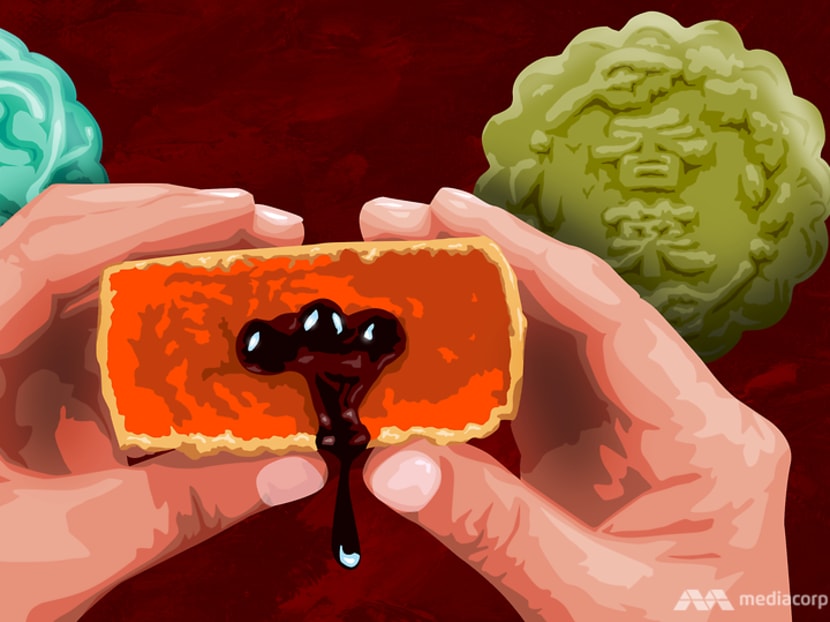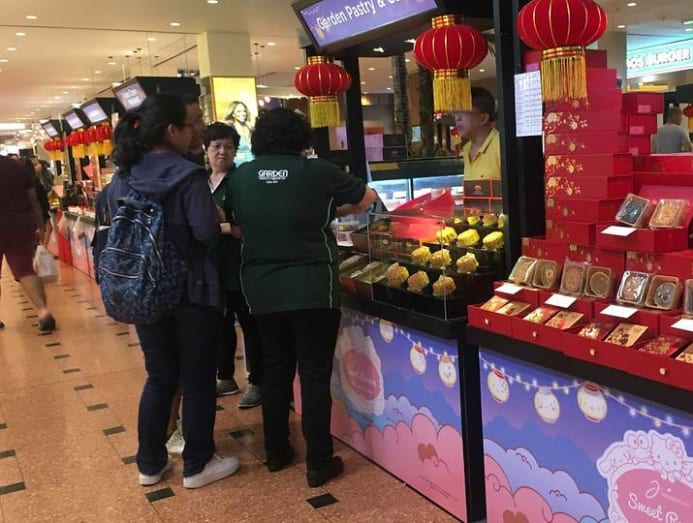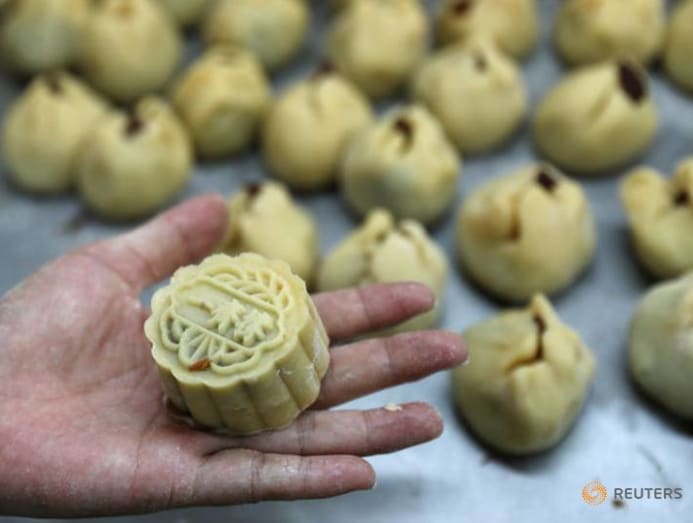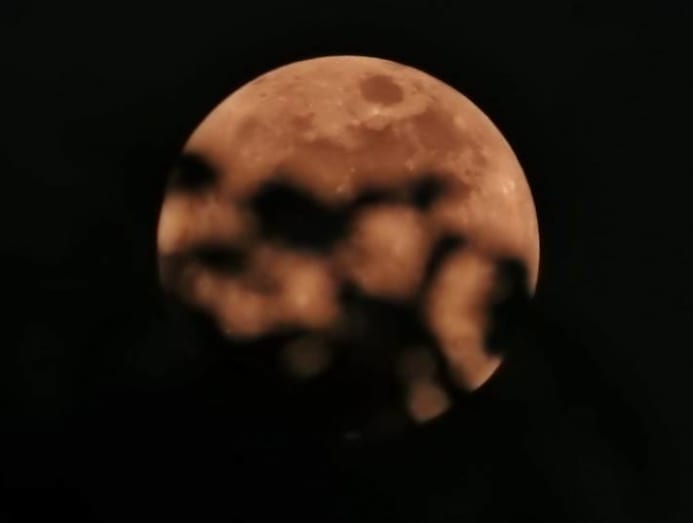commentary Commentary
Commentary: The mooncakes we buy speak volumes about ourselves
Like many Chinese cultural objects, mooncakes contain numerous symbolisms. What does their marketing and consumption tell us about ourselves today?

What new fangled mooncake flavours are you buying this Mid-Autumn Festival? (Illustration: Rafa Estrada)
SINGAPORE: The start of the Hungry Ghost Festival in August means two things.
First, this year we can for a short time be grateful we’re all required to wear masks.
Second, we’re within striking distance of the Mid-Autumn Festival, or for those who like to irritate our more erudite friends, the “Mooncake Festival”.
Historically, the Mid-Autumn Festival was a harvest celebration, noted for both commemorating the gathering of crops with the accompanying symbolisms of new life, sustenance and livelihoods, and the coming together of family.
Today, with global trade and year-round imports, the former becomes far less apparent to city dwellers, while the latter remains significant for many individuals.
LISTEN: The conversation on race and multiculturalism younger Singaporeans want
READ: Commentary: We are becoming a 'dabao nation' – why does it feel like a bad thing?
Similar to Chinese New Year, the Mid-Autumn Festival becomes an event (or excuse) for socialising and reunions, two things treasured greatly post-circuit breaker, even if it means gathering in groups of five or fewer.
OF LANTERNS AND MOONCAKES
But to many Singaporeans, two pieces of material culture are firmly etched in our psyche when it comes to the Mid-Autumn Festival.
The first is lanterns. I still remember mine – it was a goldfish and we used candles instead of LED lights, take that millenials!

The second is mooncakes.
Dense, round and sweet (but enough about me), mooncakes are the ultimate indulgence. Every year Singaporeans will fool themselves by using the “just one more small slice” strategy – only to stare blankly at the empty mooncake box at the end of the evening, and the inevitable calorie reminders from our well-meaning friends at the Health Promotion Board.
And if you’re also drinking bubble tea alongside eating mooncakes, you’re certainly made of sterner stuff.
Like many objects and food used in cultural festivals, mooncakes retain many symbolic gestures synonymous with a “good life”.
LISTEN: How many stars will you give Singapore's F&B industry this COVID-19 season?
READ: Commentary: COVID-19 has killed some friendships - but that’s okay
Roundness suggests completeness and unity – desirable traits for family structures. Sweetness denotes happiness, and traditional ingredients like nuts and egg yolks are representative of new life, growth or fertility.
Similar symbolisms can be found in other foods used in key life events like birthdays and weddings.
SO MUCH MORE CHOICE
However, in recent years, mooncakes have diversified greatly. No longer are we restricted to mere variations of nuts/no-nuts or half-yolk/full-yolk. Mooncakes now come in all kinds of varieties and sizes.
Where snowskin mooncakes used to be the cutting-edge innovation, today we have savoury, meat-filled, green tea, and even alcohol-infused mooncakes. The list is near-endless.
This diversity is a sign of a global capitalist and consumptive society, where almost everything is commodified into a product for us to buy, and sellers must compete within a market to profit and survive.
As such, it is not surprising to see companies constantly trying to outdo each other by coming up with new (and sometimes disturbing) flavours to entice customers to buy their wares, even those in sectors that on the surface, appear unrelated to mooncakes – like skincare company Innisfree or KFC.
READ: Elaborate mooncake packaging difficult to recycle and damaging to the environment, experts say
READ: Mooncake madness: Fancy a 'truffle carbonara' snow skin or Mother of Dragons?
Mooncakes, like wedding dresses, are objects individuals sometimes buy “because it’s the thing to do” or as some might say,“because of tradition”. To this extent, sellers have a bit of a captive audience – not unlike bak kua queues during Chinese New Year.
HOW MUCH FOR FOUR MOONCAKES?
It’s not surprising then to see new, opportunistic entrants into the mooncake arena every year. And when the number of conventional flavour varieties are exhausted, companies will then turn to pretty packaging to make their product stand out even more.
The result is an arms race of packaging and marketing. Instead of simple cardboard boxes, we have intricate designs and mechanisms meant to unveil the goodies.
I call this crouching mooncake, hidden calories. And of course, the more complicated the design, the pricier the package.

All these mean that mooncakes have gone from being a practical object of a ritual to becoming a symbol of both economic and cultural capital. This is not to say one buys the most expensive mooncake to show off, but it can be a useful vehicle to affirm one’s perceived epicurean and aesthetic tastes.
In other words, we are now able to choose mooncakes not because of cultural beliefs, but because they speak to our modern sensibilities and desires.
We are entranced by the marketing, and pay attention most to appearance and brand, perhaps before flavour.
The increasing complexity and ostentatious appearance of mooncakes and their accompanying packaging is not unique to Singapore. In 2013, the Atlantic reported that mooncake packaging in China had cost the country US$318 million.
THE PRODUCTION OF IDENTITY
What do we make of this? I think two things are important.
First, from a sociological point of view, the role of the producer (whether vendor, marketeer or more) is just as important as the consumer when it comes to shaping that consumer’s identity.
Social scientists are often very interested in how and what a consumer consumes, because it gives us clues into how consumers perceive themselves.
But less often do we look at the way the product was created in the first place, and the decisions and strategies that go into making such an object. For example, were these decisions a response to consumers, or a way to make consumers behave in a desired fashion and dole out huge wads of cash?
That is a question I have tried to answer in my research, especially when it comes to wedding professionals, and the roles that they play in dictating, orchestrating and scripting modern wedding rituals.
READ: Commentary: Virtual weddings are such a great idea, they should stay beyond COVID-19
READ: Commentary: Virtual solemnisation - weddings could return to basics, with opportunities and challenges
In the absence of other authority, professionals and producers play a crucial role in developing the identities (social, cultural, ethnic or otherwise) of the people they sell their goods and services to.
IT’S WHAT WE SEE IN THE MOONCAKE
The second is a reminder that more and newer is not always better. As the forces of capitalism gather pace, we are convinced that if something is shinier than it was previously, then it must certainly be better and we should purchase it.
The mooncake industrial complex is symbolic of that wider trend in society.
It is even harder to resist when the product in question is tied in with our sense of identity – that we “must” have it because if not, it would mean we are somehow incomplete. So we spend.
Of course, it is impossible to completely detach ourselves from our things, especially new things. Material objects bring us comfort and act as proxies for a great many things in our lives – identity, memory, communication, self-expression and more.
What is important then is to know that it is not what a thing is, but what it means that makes a difference to our lives.
READ: Commentary: All these corporate greeting cards and presents are not gifts. They're spam

This perspective suggests that we can spend and buy shiny stuff to make us happy, but it is really more about the values, emotions and meanings we attach to any particular object.
Furthermore, the advent of a global pandemic, lockdowns and circuit breakers have forced a rethink among many people about what really matters to us.
Is the relentless pursuit of material improvement the key to our happiness and satisfaction, or should we try to strike a balance between consumption and the more intangible aspects of life worth investing more effort into, like building good relationships and working towards a more equal society?
As our values change, so do the meanings we attach to objects. And that is something that marketeers should take note of.
In a world where we are acutely aware of climate change and reminded of the fragility of life by COVID-19, is there a way that mooncakes can be bought, gifted and wrapped in ways that appeal and support our increasing awareness around waste and the environment?
Ponder that when you next bite into your “just one more small slice” of mooncake.
Terence Heng is a senior lecturer in Sociology at the University of Liverpool, UK, where he is also an associate at the Centre for Architecture and the Visual Arts.





